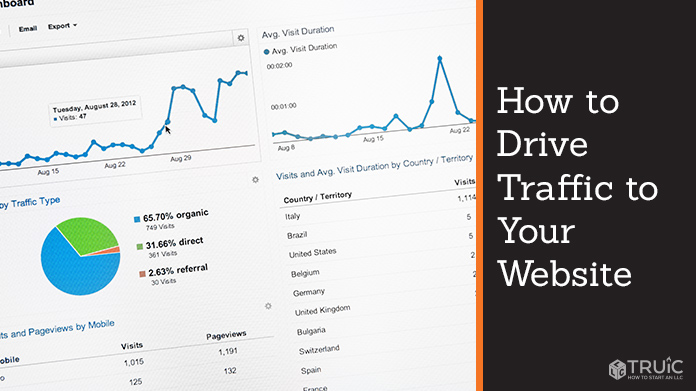How To Drive Traffic To Your Website 2025
As a small business owner looking to spread brand awareness, the first step is to create a business website. But to be successful, you’ll need to know how to drive traffic to your website.
Learn about search engine optimization (SEO) and the tools you can use to gain increasing traffic to your website. We’ll even cover several ways to make sure your business website is successful well into the future. Keep reading to discover key methods you can use to drive traffic to your website or online store.
Recommended: Check out our Best Website Builder Review to make sure your website builder has everything you need.

Methods for Increasing Website Traffic
Driving visitors to your website requires attracting the right audience. Ideally, your site will convince its target market to stay long enough to engage with — and possibly purchase — whatever it sells.
This process takes time and effort to create a strategy that works well for your business. It often involves a combination of paid and free (also called “organic”) methods that fall into two main categories: improving site content and prioritizing search engine optimization (SEO).
Improving Site Content
In online marketing, content is king. Sites that offer engaging content will help ensure visitors return whether the site features blog posts or other specific content. You can improve your site’s content in a variety of ways, such as by ensuring it clearly focuses on your target topic or market, updating it regularly, and enriching it with keywords.
Focus on Your Target Topic or Market
Focusing your site’s content on just your business’ target topic or market will make it engaging to your target audience. This approach also can help ensure your site’s content never grows too dispersed, which can prevent it from attracting new visitors looking for sites that address a specific “problem.”
Make Regular Updates
Updating your content frequently not only will improve the quality of your website, but also improve its Google ranking. Google bases its website rankings on a system in which it sorts content by its relevance and usefulness as well the number of links going to a specific web page.
Create Keyword-Rich Content
Boosting your site traffic also requires a solid understanding of keywords: the specific words or terms people use in search engines like Google. To determine the right set of keywords for your site, consider your target audience’s search intent and then research words relevant to that intent. What terms might they use when searching for the type of products or services your business offers?
Once you compile a list of keywords your target audience likely uses in online searches, you can enrich your site’s content with them to help attract members of that audience.
For example, consider a specific blog post idea and try to determine the keywords associated with it and how people might search for that topic. Numerous keyword search tools can help you with this process, such as the Google Ads Keyword Planner.
Prioritizing SEO
SEO is an important — if not the most important — principle to understand when it comes to driving organic traffic to a website. SEO allows content to rank at the top of search engine results when people search for specific terms.
As you start the process of driving traffic to your website, familiarize yourself with the two main types of SEO: on-page SEO and off-page SEO.
On-Page SEO
On-page SEO refers to what’s directly on a website and its web pages, including the type of content, the visual and textual elements, the layout and navigation, and the more technical aspects like coding. Website creators have more control with on-page SEO because they can choose the quality of a site’s content and coding to improve its search engine ranking.
To improve your website’s on-page SEO, consider the techniques outlined below.
Add Keywords to Titles and Headings
It’s a best practice to insert keywords in a website’s title tags — the clickable titles that appear in search engines for a web page. Additionally, headings usually gain more visibility on search engines due to their size rather than the written content beneath them. That means adding keywords to headings will increase the focus on a web page’s specific content.
Create More-Effective URLs
Another way to improve your website’s visibility and indicate what content it contains is to embed keywords within its URLs — the addresses that lead users to a specific website or web page. Ideally, those URLs should contain short, clear keywords.
Add Images and Videos
The addition of images and videos to a website increases its content diversity and promotes longer engagement times with site visitors. It also can reduce a site’s bounce rate — how often visitors enter and leave a site without engaging with its web pages. Sites with greater visitor engagement have a better chance of ranking higher in search engine results.
When adding images, remember to use alternative text (alt text) to caption each image. This ensures search engines like Google will recognize that content and can help get those images listed within the search engine’s image search results. Using alt text also will ensure your website follows the Web Content Accessibility Guidelines (WCAG), which promote the accessibility of web content to different users like the disabled and elderly.
Increase Page Responsiveness and Mobile-First Indexing
More than 50 percent of global website traffic now comes from mobile devices, according to Statista.com. Web pages that load faster, especially on mobile devices, have a better chance of ranking higher on search engines. Search engines like Google also use the mobile version of a website’s content to rank it in their search results — a system referred to as mobile-first Indexing.
The responsiveness of a web page, whether on a mobile device or desktop, is an important part of retaining website traffic. If a page loads quickly, visitors likely will stay longer and the page will earn a higher ranking on search engines because it provides a better user experience.
You can use a variety of tools to evaluate the loading speed of your website. Google’s PageSpeed Insights, for example, analyzes page speed on mobile or desktop devices and provides suggested improvements. Other ways to ensure faster page-loading times include setting browser caching to durations of more than a week, using smaller image sizes, using above-the-fold content loading, and ensuring your site’s server response time remains less than 200 milliseconds.
Use Featured Snippets In “Position Zero”
Featured snippets are content boxes that appear at the top of a search results page — also referred to as “position zero” — and have the highest search engine ranking. Once a search engine ranks a site’s content on the first page of its results, website owners can start to use their content as featured snippets.
Featured snippets can include question-oriented content like “how to,” “what is,” “who is,” “why is,” or “best of.” Structuring a website’s content to make it acceptable as a featured snippet will help place that website more strategically on search engine results and, in the long run, improve its overall traffic.
Off-Page SEO
Off-page SEO, also known as domain authority, refers to what happens beyond a website’s pages that ultimately impacts its search engine ranking. This can include social media marketing as well as the volume of backlinks — shared links from one web page that redirect visitors to the originating website. Backlinks create more exposure for a business beyond its website, but the quality of those links is just as important as the quantity.
To improve your site’s off-page SEO, consider the techniques outlined below.
Referral Traffic
Referral traffic consists of page visitors who click a link on one website that leads to a different website. Such “referral visits” usually occur outside of search engines. When one website refers visitors to another, it indicates a reputable site that’ll increase the chances of more online traffic.
One way to generate referral traffic involves writing a guest post for another blog or website. Readers of that post may then click on a provided link to the guest author’s website. Guest blogging also can foster connections with other well-known leaders in a specific industry. As such, it can prove useful to include links to their sites to foster new relationships in the industry and find new readers or subscribers.
Another way to drive referral traffic involves social media posts that provide a link to your business website. For example, Instagram posts usually include the “link in bio” option. Leaving comments as a guest on another blog or website also can lead to more referrals if those comments add strategic value for readers.
Affiliate Traffic
Affiliate marketing — another approach to increasing website traffic — provides a lucrative option for sites that offer goods or services. With this technique, an affiliate markets another company’s products or services on its platform. The affiliate then earns a commission whenever someone clicks on the affiliate platform link that leads to the other company’s website.
Social Media Marketing
Social media marketing also offers an effective way to drive website traffic from a wide range of social media platforms.
Businesses can use social media posts to promote new blog content about their products and services as well as the evolving trends and issues affecting their target audience. Sharing those social media posts as often as possible will build a following over time, but creating a formal sharing schedule will ensure more consistent website traffic growth.
In addition, the use of images in social media posts typically attracts more audience engagement. Publishing an individual post more than once also can drive traffic to a website if you leave enough time between each publishing date.
Other Types of SEO
Other common types of SEO include “white hat SEO” and “black hat SEO,” which address the ethical boundaries of SEO practices.
White hat SEO adheres to Google-approved guidelines and techniques, such as using keywords and optimizing a web page’s usability. Black hat SEO uses shortcuts to help a website rank higher in search engines, and these practices usually violate a search engine’s user policies.
To learn more, read our guide on How To Improve SEO.
Methods for Driving Traffic To Local Businesses
Local businesses that operate brick-and-mortar stores also can use online marketing tools to drive traffic to those stores as well as their websites. Content marketing can help promote products or services through a blog on a business website, and, with smart use of keywords, a business can increase its ranking on search engines like Google.
Consider the methods outlined below if you also want to drive traffic to a brick-and-mortar location.
Get a Google Business Profile Account
With a Google Business Profile (formerly Google My Business), a local business can create a profile that includes all the key information about the company from contact details and addresses to hours of operation, website addresses, photos, and GPS coordinates. Customers can leave reviews and businesses can customize their profiles to suit their specific needs and industry.
Run Pay-Per-Click (PPC) Campaigns
Businesses can boost both website and foot traffic by running scaled and targeted PPC campaigns on digital channels like Facebook Ads, Google, and Yahoo! Search as well as via LinkedIn Marketing Guide.
PPC advertising campaigns earned their popularity because they offer immediate results. Once a business approves its PPC ad, millions of people can see it immediately on platforms they already trust.
Summary
Any business — whether it’s completely online, just has brick-and-mortar stores, or operates in both environments — can use a variety of techniques to drive more traffic to its website and physical locations.
While no single strategy can provide guaranteed results, businesses should primarily focus on creating quality content that’ll attract more online visitors. By understanding how each of the methods and techniques outlined here work, website owners can apply those best suited to their needs to improve their site’s visibility on search engines and attract more visitors who may eventually become potential customers.


